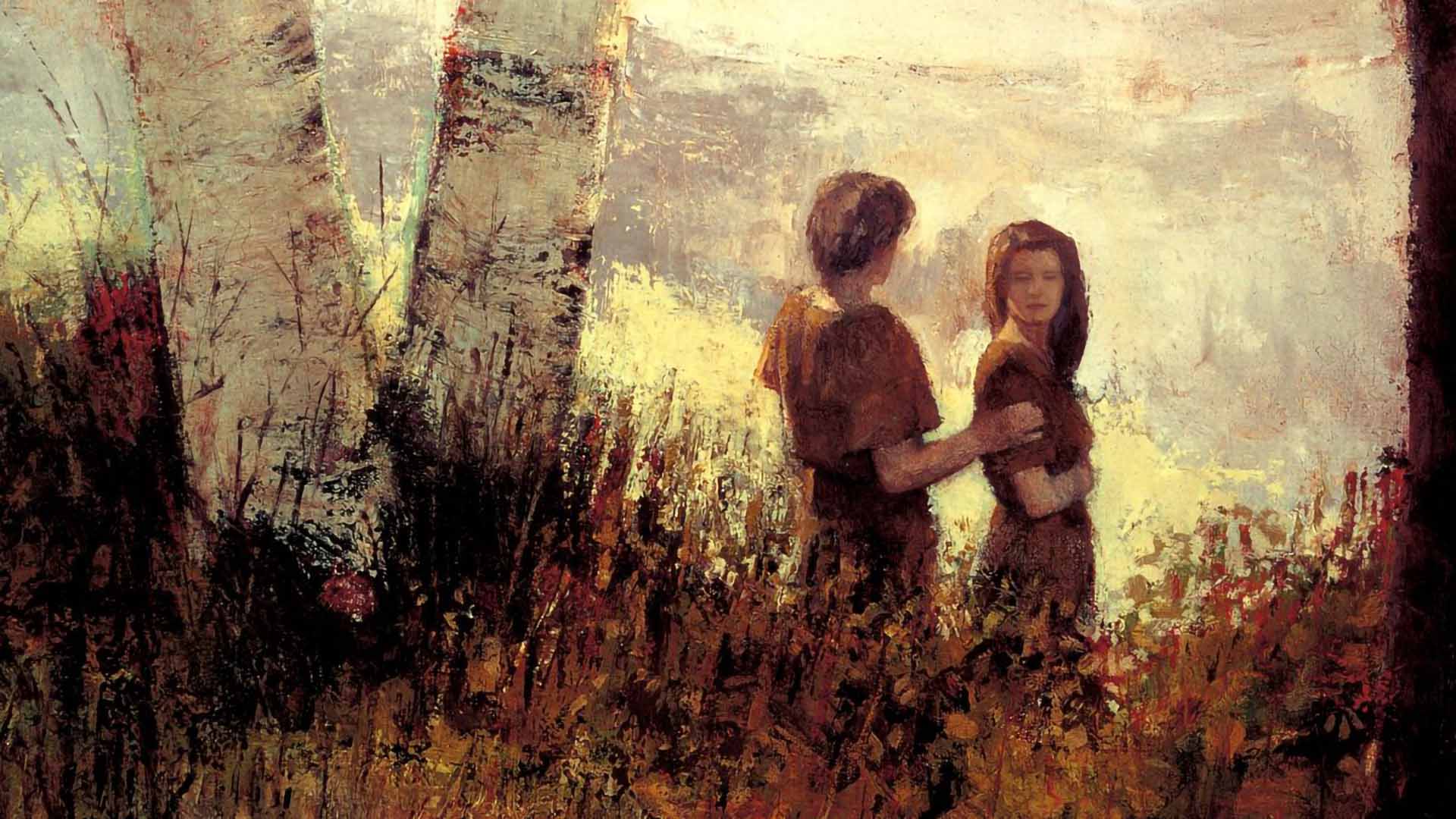You are here
Book of Mormon Central is in the process of migrating to our new Scripture Central website.
We ask for your patience during this transition. Over the coming weeks, all pages of bookofmormoncentral.org will be redirected to their corresponding page on scripturecentral.org, resulting in minimal disruption.

Genesis 3–4; Moses 4–5
Videos
Bible Central Chapter Guides
Daily Reading Plan
Monday
- Daily Verse: Moses 4:12
- Video: Casey Paul Griffiths, What Happened Before the Creation and Fall?
- Scripture: Genesis 3:1–7
- Scripture: Moses 4:1–11
Further Reading
Tuesday
- Daily Verse: Moses 4:14
- Video: Marianna Richardson, Can We Truly Hide from the Lord?
- Scripture: Genesis 3:8–19
- Scripture: Moses 4:12–25
Wednesday
- Daily Verse: Moses 4:26
- Video: Taylor Havlerson, The Clothing and of Adam and Eve and the Tree of Life
- Scripture: Genesis 3:20–24
- Scripture: Moses 4:26–32
Thursday
- Daily Verse: Moses 5:6
- Video: John Hilton III, Obeying When You Don't Understand Why
- Scripture: Moses 5:1–15
Friday
- Daily Verse: Moses 5:16
- Video: Jasmin Gimenez Rappleye, Cain and Abel and the Fall
- Scripture: Genesis 4:1–8
- Scripture: Moses 5:16–33
Saturday
- Daily Verse: Moses 5:34–35
- Video: Lynne Hilton Wilson, Comparing Cain and Abel (Moses 5)
- Scripture: Genesis 4:9–16
- Scripture: Moses 5:34–41
Sunday
- Daily Verse: Moses 7:32
- Video: Lynne Hilton Wilson, Agency and the Fall
- Scripture: Genesis 4:17–26
- Scripture: Moses 5:42–59
Bibliography
Genesis 3
LeGrand L. Baker, “The Cosmic Mountain Represents the Garden of Eden,” in The Book of Mormon as an Ancient Israelite Temple: Nineteen Classic Temple Characteristics of the Book of Mormon (Salt Lake City: Eborn Books, 2012), 32-35.
Book of Mormon Central, “Why We Still Have to Cling to the Iron Rod Even Though the Path is Strait (1 Nephi 8:13–14),” KnoWhy 402 (January 25, 2018).
Matthew L. Bowen, “Cut Off from the Face and Presence: Alma’s Use of Hebraistic Idioms to Teach the Fall,” Religious Educator 21, no. 2 (2020): 157–169.
Jeffrey M. Bradshaw, “The Tree of Knowledge as the Veil of the Sanctuary,” in Ascending the Mountain of the Lord: Temple, Praise, and Worship in the Old Testament (2013 Sperry Symposium), ed. Jeffrey R. Chadwick, Matthew J. Grey, and David Rolph Seely (Provo, UT: Religious Studies Center, Brigham Young University; Salt Lake City: Deseret Book, 2013), 49–65.
David M. Calabro, “Lehi’s Dream and the Garden of Eden,” Interpreter: A Journal of Latter-day Saint Faith and Scholarship 26 (2017): 269–296.
Alex Douglas, “The Garden of Eden, the Ancient Temple, and Receiving a New Name,” in Ascending the Mountain of the Lord: Temple, Praise, and Worship in the Old Testament (2013 Sperry Symposium), ed. Jeffrey R. Chadwick, Matthew J. Grey, and David Rolph Seely (Provo, UT: Religious Studies Center, Brigham Young University; Salt Lake City: Deseret Book, 2013), 36–48.
Taylor Halverson, “Was Adam a Monotheist? A Reflection on Why We Call Abraham Father and Not Adam,” Interpreter: A Journal of Latter-Day Saint Faith and Scholarship 31 (2019): 245–258.
F. Melvin Hammond, “The Gospel of Jesus Christ in the Old Testament,” in The Gospel of Jesus Christ in the Old Testament, The 38th Annual BYU Sidney B. Sperry Symposium (Provo, UT: Religious Studies Center, Brigham Young University, 2009), 1–16.
Daniel K. Judd, “The Fortunate Fall of Adam and Eve,” in No Weapon Shall Prosper: New Light on Sensitive Issues, ed. Robert L. Millet (Provo, UT: Religious Studies Center, Brigham Young University; Salt Lake City: Deseret Book, 2011), 297–328.
Roger R. Keller, “Teaching the Fall and the Atonement: A Comparative Method,” Religious Educator 5, no. 2 (2004): 101–118.
Robert J. Matthews, “The Probationary Nature of Mortality,” in The Book of Mormon: Alma, the Testimony of the Word, ed.Monte S. Nyman and Charles D. Tate Jr. (Provo, UT: Religious Studies Center, Brigham Young University, 1992), 47–60.
Tyler J. Griffin and Donald B. Anderson, “The Great Plan of Happiness: A Christ-Centered Visual Approach,” Religious Educator 18, no. 1 (2017): 12–31.
Stephen D. Ricks, “Adam's Fall in the Book of Mormon, Second Temple Judaism, and Early Christianity,” in The Disciple as Scholar: Essays on Scripture and the Ancient World in Honor of Richard Lloyd Anderson, eds. Stephen D. Ricks, Donald W. Parry and Andrew H. Hedges (Provo, UT: Foundation for Ancient Research and Mormon Studies, 2000), 595-606.
Andrew C. Skinner, “Savior, Satan, and Serpent: The Duality of a Symbol in the Scriptures,” in The Disciple as Scholar: Essays on Scripture and the Ancient World in Honor of Richard Lloyd Anderson, eds. by Stephen D. Ricks, Donald W. Parry and Andrew H. Hedges (Provo, UT: Foundation for Ancient Research and Mormon Studies, 2000), 359-384.
Julie M. Smith, “A Redemptive Reading of Mark 5:25-34,” Interpreter: A Journal of Latter-day Saint Faith and Scholarship 14 (2015): 95–105.
Genesis 4
RoseAnn Benson, “The Marriage of Adam and Eve: Ritual and Literary Elements,” in By Our Rites of Worship: Latter-day Saint Views on Ritual in Scripture, History, and Practice, ed. Daniel L. Belnap (Provo, UT: Religious Studies Center; Salt Lake City: Deseret Book, 2013), 107–131.
Book of Mormon Central, “Why Are Secret Combinations Associated with Cain and Getting Gain? (Ether 8:22),” KnoWhy 585 (November 17, 2020).
Matthew L. Bowen, “Getting Cain and Gain,” Interpreter: A Journal of Latter-day Saint Faith and Scholarship 15 (2015): 115–141.
Taylor Halverson, “Was Adam a Monotheist? A Reflection on Why We Call Abraham Father and Not Adam,” Interpreter: A Journal of Latter-Day Saint Faith and Scholarship 31 (2019): 245–258.
Moses 4
Book of Mormon Central, “Why Did Lehi Teach that the Fall was Necessary? (2 Nephi 2:22–25),” KnoWhy 269 (February 1, 2017).
Reynolds, Noel B. “The Brass Plates Version of Genesis.” Interpreter: A Journal of Latter-day Faith and Scholarship 34 (2019): 63–96.
Reynolds, Noel B., and Jeff Lindsay. “‘Strong like unto Moses’: The case for ancient roots in the Book of Moses based on Book of Mormon usage of related content apparently from the Brass Plates.” Presented at the conference entitled “Tracing Ancient Threads of the Book of Moses’ (September 18–19, 2020), Provo, UT: Brigham Young University 2020. https://interpreterfoundation.org/conferences/2020-book-of-moses-conference/.
Moses 4:1-4
Jeffrey M. Bradshaw, “Satan’s Original Glory and the Symbols of Kingship,” Book of Moses Essay 59 (June 11, 2021).
Jeffrey M. Bradshaw, “The Willing and Unwilling Sons in the Council in Heaven,” Book of Moses Essay 60 (June 18, 2021).
Lindsay, Jeffrey Dean. “‘Arise from the Dust’: Insights from Dust-Related Themes in the Book of Mormon. Part 1: Tracks from the Book of Moses.” Interpreter: A Journal of Latter-day Saint Faith and Scholarship 22 (2016): 179–232.
Welch, John W. “Symbolism in the Parable of the Willing and Unwilling Two Sons in Matthew 21.” In Let Us Reason Together, edited by J. Spencer Fluhman and Brent L. Top, 97–116. Provo: BYU Religious Studies Center, 2016.
Moses 4:6-12
Bradshaw, Jeffrey M. “The tree of knowledge as the veil of the sanctuary.” In Ascending the Mountain of the Lord: Temple, Praise, and Worship in the Old Testament, edited by David Rolph Seely, Jeffrey R. Chadwick and Matthew J. Grey. The 42nd Annual Brigham Young University Sidney B. Sperry Symposium (26 October, 2013), 49–65. Provo and Salt Lake City, UT: BYU Religious Studies Center and Deseret Book, 2013.
Jeffrey M. Bradshaw, “The False and the True Keeper of the Gate,” Book of Moses Essay 63 (July 10, 2021).
Jeffrey M. Bradshaw, “Was Eve Beguiled?,” Book of Moses Essay 67 (August 7, 2021).
Moses 4:13
Jeffrey M. Bradshaw, “The False Apron and the Tree of Death and Rebirth,” Book of Moses Essay 64 (July 17, 2021).
Moses 4:14–21
Jeffrey M. Bradshaw, “A Curse for the Serpent,” Book of Moses Essay 65 (July 24, 2021).
Jeffrey M. Bradshaw, “The Nakedness and Clothing of Adam and Eve,” Book of Moses Essay 68 (August 13, 2021).
Moses 4:22–26
Jeffrey M. Bradshaw, “The Challenges and Blessings of Celestial Marriage,” Book of Moses Essay 66 (July 31, 2021).
Jeffrey M. Bradshaw, “The Temple Work of Adam and Eve,” Book of Moses Essay 70 (August 28, 2021).
Moses 4:29–31
Jeffrey M. Bradshaw, “Stand Ye in Holy Places and Be Not Moved,” Book of Moses Essay 69 (August 21, 2021).
Moses 5
Bowen, Matthew L. “Getting Cain and Gain.” Interpreter: A Journal of Latter-day Saint Faith and Scholarship 15 (2015): 115–141.
Calabro, David. “‘This Thing Is a Similitude’: A Typological Approach to Moses 5:1–15 and Ancient Apocryphal Literature.” Presented at the conference entitled “Tracing Ancient Threads of the Book of Moses” (September 18–19, 2020), Provo, UT: Brigham Young University 2020.
Moses 5:7
Book of Mormon Central, “How the Law of Moses Teaches about the Atonement (Alma 34:14),” KnoWhy 424 (April 12, 2018).








